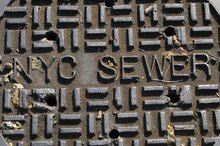Signs You Have Natural Gas on Your Property
Natural gas is a term used in reference to a number of flammable, gaseous fossil fuels. These largely consist of methane, methane derivatives, and hydrocarbons (compounds made of hydrogen and carbon). Natural gas is commonly used to heat homes, as well as for cooking on gas ranges. If you are lucky enough to discover natural gas on your property, you may be able to sell it for a handsome profit.
Surface Conditions
You may be able to detect the presence of natural gas on your property by observing the condition of the surface soil and plant life. According to alliantenergy.com, the unexpected drying out or dying off of grass and other vegetation may indicate that there is natural gas beneath the surface. Typically, though, this is the result of a leaking pipe, as opposed to a natural deposit. According to need.org, large amounts of coal in your property’s soil could indicate a natural deposit of coalbed methane, which is a natural gas trapped between layers of coal deposits.
- You may be able to detect the presence of natural gas on your property by observing the condition of the surface soil and plant life.
- According to need.org, large amounts of coal in your property’s soil could indicate a natural deposit of coalbed methane, which is a natural gas trapped between layers of coal deposits.
Adjacent Deposits
Health Problems Related to Natural Gas Leaks
Learn More
According to geology.com, natural gas is able to seep through tiny fractures in rock and mineral layers beneath the ground 1. This process allows it to travel across vast subterranean distances, including across property lines. So if the owner of a neighboring or otherwise close-by property has “struck” natural gas, there is an increased likelihood that natural gas lies beneath your property. As the above source points out, though, you should act fast because it is possible for neighbors to “steal” the gas out from beneath your feet (the downside of natural gas being able to move so easily underground).
Sound Waves
A more scientific approach for determining whether you have natural gas on your property is to shoot sound waves down through the soil and record them as they bounce back to the surface. According to need.org, you can create these waves by dropping a weighted object onto your property or through the use of small, controlled explosions. Of course, you should seek the help of a geologist or other qualified professional before attempting any of these types of tests.
Gravity
The Differences Between Natural Peridot & Peridot Cubic Zirconia
Learn More
A geologist may also be able to help you locate natural gas on your property--according to need.org--by measuring the gravitational pull of the underlying ground formations. One way to do this is by making pendulum measurements, wherein you estimate the gravitational acceleration in a particular area by measuring the oscillation of a pendulum.
Odor
Natural gas is tasteless and odorless. According to alliantenergy.com, when natural gas is piped into a home, an odorant is added (called mercaptan) so that leaks can be more easily detected. So if your property begins to smell of rotten eggs, this is not an indication of a natural gas deposit but of a leaking pipe.
Related Articles
References
Writer Bio
Erik Devaney is a writing professional specializing in health and science topics. His work has been featured on various websites. Devaney attended McGill University, where he earned a Bachelor of Arts in humanistic studies.








